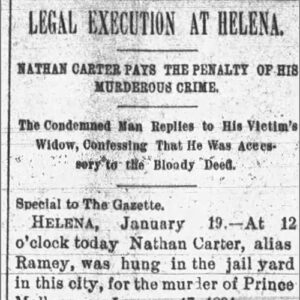calsfoundation@cals.org
Nathan Carter (Execution of)
Nathan Carter, who was hanged at Helena (Phillips County) on January 19, 1893, was one of two African American men executed for the murder of Prince Maloy, a “well to do negro planter.”
Prince Maloy, fifty-nine, and his wife Matilda, fifty-one, lived on Island No. 64 in Phillips County’s Mooney Township south of Helena with their son William, age eighteen. Maloy hired local men—including Nathan Carter, Isom White, and his step-son Henry Young—to work in his fields, and their relationships could be tense; a newspaper report said that a few weeks before Christmas 1890 they got into an argument, “and but for the prompt interference of Molloy’s [sic] wife they would have killed the old man.”
Maloy was known to keep cash in his house in order to pay his workers. On January 2, 1891, White and Young borrowed a shotgun, ostensibly to go hunting, but instead went to Maloy’s house with Carter. They shot the old farmer to death, and Matilda and William Maloy fled to the woods, but not before recognizing the assailants.
Matilda Maloy took the steamboat Kate Adams to Helena, where she spotted White and followed him until she ran into the town’s mayor, who ordered White arrested after hearing her story. Young was arrested the same day, and items stolen from the Maloy house were found in their possession. After a few weeks in jail, Young made a full confession.
In early June, Young entered a guilty plea to second-degree murder in the case and was sentenced to fifteen years in the Arkansas State Penitentiary. White was tried a few weeks later, convicted of first-degree murder, and hanged on July 31, 1891.
Carter fled to St. Louis, Missouri, where he lived under the alias John Ramey until he was captured by detectives on June 4, 1892. Helena police chief Frank E. Casey went to St. Louis to return him to Phillips County, but Carter fought extradition for several days before being transported to Arkansas. A St. Louis newspaper noted that “Carter’s chances for the gallows are good.”
He was tried in Helena on December 6, and Young was pardoned from his prison sentence so that he could testify against Carter. He was convicted of first-degree murder, and when the judge announced that he would be executed on January 19, 1893, “Carter fainted and fell forward flat on his face. He was with difficulty restored to consciousness and had to be carried out of the court room, fainting twice on the way to jail.”
A reporter noted on January 19 that “the condemned man was remarkably cool and ascended the steps of the scaffold with a firm step.” Matilda Maloy, who was among the witnesses, asked Carter if he killed her husband, to which he replied, “Well, if I did not kill him, I helped do it, for I shot him six or seven times.”
Carter asked her for her forgiveness, and “a moment afterwards the trap fell. The man’s neck was broken by the fall and he died in a few minutes.”
For additional information:
“After Carter, the Murderer.” St. Louis [Missouri] Globe-Democrat, June 11, 1892, p. 6.
“Carter Will Hang.” Arkansas Gazette, December 10, 1892, p. 1.
“Caught Her Husband’s Assassins.” Southern Standard, January 23, 1891, p. 1.
“Confessed and Died.” Memphis [Tennessee] Weekly Commercial, January 25, 1893, p. 2.
“Identified as Murderer.” St. Louis [Missouri] Post-Dispatch, June 10, 1892, p. 6.
“Legal Execution at Helena.” Daily Arkansas Gazette, January 20, 1893, p. 4.
“Nathan Ramy Will Hang.” St. Louis Globe-Democrat, December 7, 1892, p. 5.
Mark K. Christ
Central Arkansas Library System
 Law
Law Post-Reconstruction through the Gilded Age, 1875 through 1900
Post-Reconstruction through the Gilded Age, 1875 through 1900 Nathan Carter Execution Article
Nathan Carter Execution Article 




Comments
No comments on this entry yet.